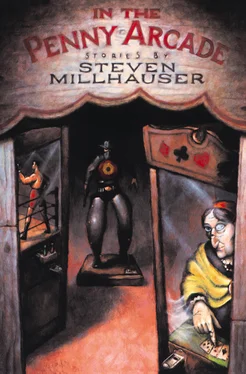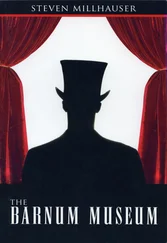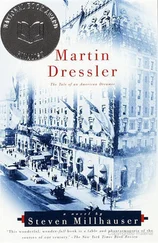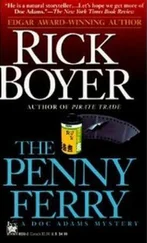Hausenstein spoke a great deal that night, and not only about the art of automatons. Not all of what he said made sense to August, for Hausenstein, despite his gift of exact criticism, was given to the spinning of elaborate theories, but one idea did make a strong impression on him. Hausenstein maintained that the nineteenth century was above all the century of motion. By this he did not mean simply, or even primarily, that the age was obsessed with speed: frankly, trains bored him, though this did not prevent him from seeing their spiritual significance, and incidentally there was a rather nice description of a moving landscape watched from a train in a little poem by Verlaine in La Bonne Chanson which was probably the first description in French verse of this very modern phenomenon. Someday he would perhaps write a little paper comparing such descriptions with earlier ones of landscapes glimpsed from coaches. But trains were only a crude expression of the century’s love of motion, which was far more strikingly expressed in its arts and entertainments. The new painters in France, for instance, might speak as much as they liked about sunlight and chromatic values; what struck an observer above all in the curious products of l’impressionisme was the sense of leaves stirring, of reflections rippling, of air trembling — it was an art consisting entirely of shimmer and vibration, of solid things broken into trembling points: sunlight as motion, the universe as nothing but motion. But such effects were capable of only a moderate development and would inevitably be replaced by the far more compelling illusions of motion that the century was already developing in its popular entertainments. Photography, that characteristic invention of the age, was considered by many learned gentlemen to have driven painting into the excesses of the modern school, but these same gentlemen would do better to realize that l’impressionisme was merely one expression of a much wider tendency. More than a decade before Daguerre displayed his first light-picture in 1839, a far more important discovery had been made in the realm of optics. It was discovered that an image cast onto the retina remains there for a fraction of a second after the object is removed. This profoundly significant phenomenon — surely August had heard of persistence of vision? — had been demonstrated by means of an ingenious toy. It was called the thaumatrope, and was no more than a small paper disk with a different image on each side: a bald man on one side and a toupee on the other, a parrot on one side and a cage on the other. Strings were attached to the opposite ends of the disk to permit twirling. When the disk whirled about, the two different images merged into one: the bald man wore his toupee, the parrot sat in the cage. But the thaumatrope, while demonstrating the principle of persistence of vision, did not present the illusion of motion. It was in 1832 that Monsieur Plateau invented his phenakistoscope, lovely name, that slotted disk attached to a handle and spun before a mirror. On one side of the disk a number of drawings were arranged in phase, and when the disk was rotated before the mirror, the reflected image viewed through the whirling slots became a single continuous motion: the little girl skipped rope. Thus was born the moving image, which already in this crude and childish form surpassed the effects of the clockwork pictures of the previous century. There had followed a stream of charming and ingenious toys, each improving the illusion of motion and each bearing a splendid name — but he would not bore August to death with descriptions of the zoetrope, the praxinoscope, and other such toys of genius. He would mention only that as early as mid-century the magic lantern had been combined with one of these devices to project moving images on a screen. And at this very moment, in Paris, the brilliant Emile Reynaud, using his own praxinoscope, was projecting colored moving pictures onto a background cast by a second projector. These pictures were all of course painted by hand, but it was only a matter of time before the photograph itself — that authoritative illusion — would be used in place of the hand-painted picture. Indeed, serial photographs had already been invented across the ocean, in dear old America; it remained only for some sublime tinkerer to discover a practical way to produce and project them. Then a new art would be born, and the century’s striving for the illusion of motion would at last be satisfied. It was amusing that Daguerre, the inventor of light-pictures, had also invented that hoary popular entertainment the Diorama, which had drawn large crowds early in the century with its quite different illusions of motion, produced by ingenious lighting effects, and doomed to extinction. L’impressionisme , the Diorama, pictures that move — these were the inventions that he found far more revealing than the railroad and the dynamo, for in these arts the century’s love of motion had invaded a medium that by its very nature was motionless.
And that brought him round to August; he apologized if he had talked too much already, he hated bores. For August too was part of the century’s great tendency. True, he had chosen an eighteenth-century form, one might say an obsolete form, but he had developed it so much further than the old automatists had done that in his hands it became almost new. He had simply carried their experiments to an extreme — and what more modern than this lack of a sense of bounds, this need to take something as far as it would go? The art of the automaton was a dead art — he hoped August did not deceive himself into thinking otherwise — but in August’s hands it had taken on a last, brilliant life, it had achieved a realism surpassing the old art of waxwork, for his fanatically imitative figures seemed to live and breathe. And because the age desired the illusion of motion, and because the devices that made pictures move were still in a crude state, and because the photograph had not yet been adapted to its final purpose — because of all this, the time was right for an automaton theater. He did not want August to think that he hadn’t considered the matter rather carefully.
August scarcely knew what to make of this speech, which he had not been able to follow in all its turnings — he himself was accustomed to thinking mostly with his fingers — but one thing struck him forcibly: he did not like to be told that he was out of step with his time, or in step with his time. He felt that his work had nothing whatever to do with such questions, which obscurely threatened him by ignoring everything that mattered most. What mattered was that one day in a drab green tent something had lit up in him and had never gone out. The art of clockwork was his fate, but clockwork was also a sort of accident; what he cared about was something else, which had no name and had only an accidental relation to time and place. He did not say any of this to Hausenstein, but he was grateful to Hausenstein for having made him have those thoughts. The long speech had another curious effect: somehow, and he could not quite say why, he felt sorry for Hausenstein, and knew that he must never reveal this to him. The evening exhausted August, but before it was over he had decided to go to Berlin. He would need six months in Mühlenberg to solve three clockwork problems. Hausenstein said that he himself planned to knock about for a few months before getting down to business. When he rose to leave, he drew on his gloves, picked up his walking stick, and remarked, “Amusing, isn’t it?” Suddenly the grimacing troll snapped its jaws shut. August was uncertain whether Hausenstein’s words had referred to the clever troll, to the automaton theater, or to life itself.
A few weeks later August received a postcard from Genoa, which Hausenstein said was hot and boring, and three days after that a postcard from Vienna, containing the single word “Ciao,” and then nothing at all for five and a half months, when he received a card from Berlin, telling him what train to take and where to get off. Somewhat to August’s surprise, Hausenstein was there at the station to meet him, looking entirely the same, and behaving as if they had last spoken a few hours ago. It was ten at night and August had been traveling since early morning. Hausenstein hailed a cabriolet and soon August found himself clattering through a district of narrow streets and bright-flaring gas jets that lit with a smoky green-yellow glow the masklike faces of Damen and Herren on the sidewalks. There were shouts of laughter, a light piano tune burst from a passing doorway, through a dimly lit window came a clash of steins. A lady in a great wide-brimmed hat and a feather boa walked arm in arm with a little pale bald man who had a large, beautiful, shiny-black mustache. The cab turned into a darker but still lively side-street and stopped. August hoped the hotel room would not be facing the street. Hausenstein, carrying one of August’s traveling bags, led him to a narrow doorway half-illuminated by a nearby light. He drew out a great iron key, opened the door, and lighting a match led August along a narrow, dark corridor at the end of which was a curtain. August followed him through the curtain; the match went out. Hausenstein fumbled about in the blackness and at last lit a gaslamp. August saw that he was standing at the back of a high small room with rows of seats and a stage. “Like it?” said Hausenstein, and still for another second or two August could not understand where he was.
Читать дальше












